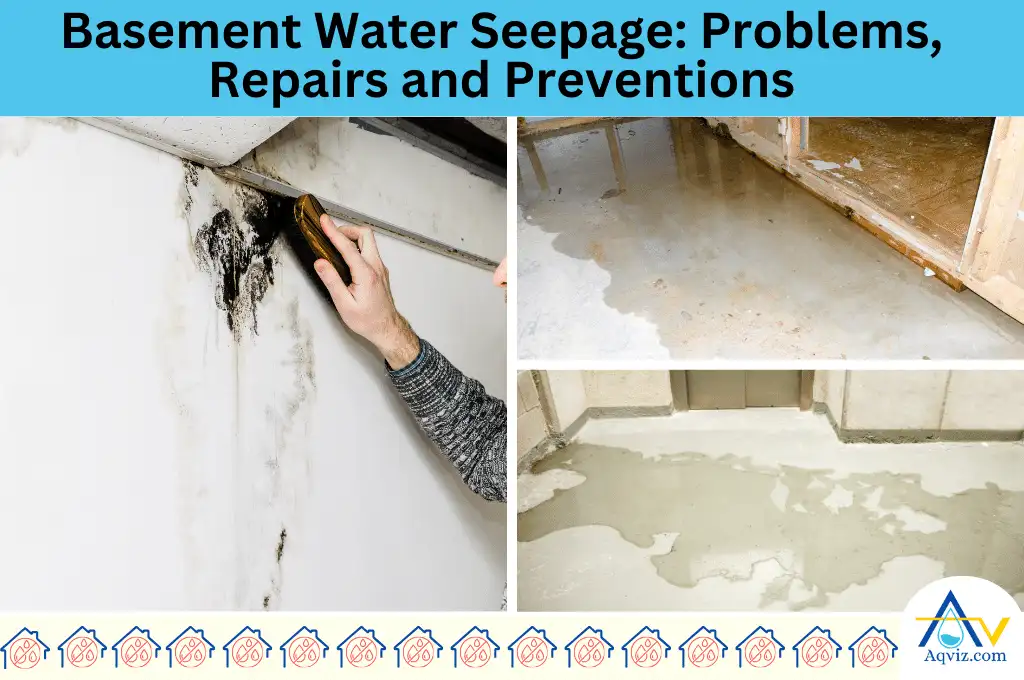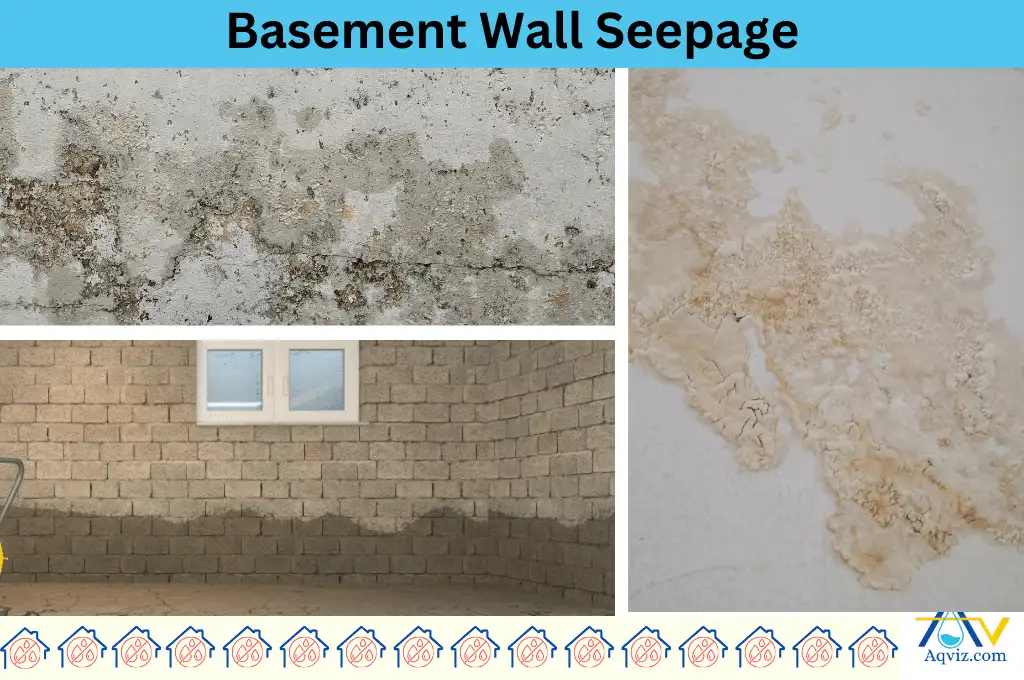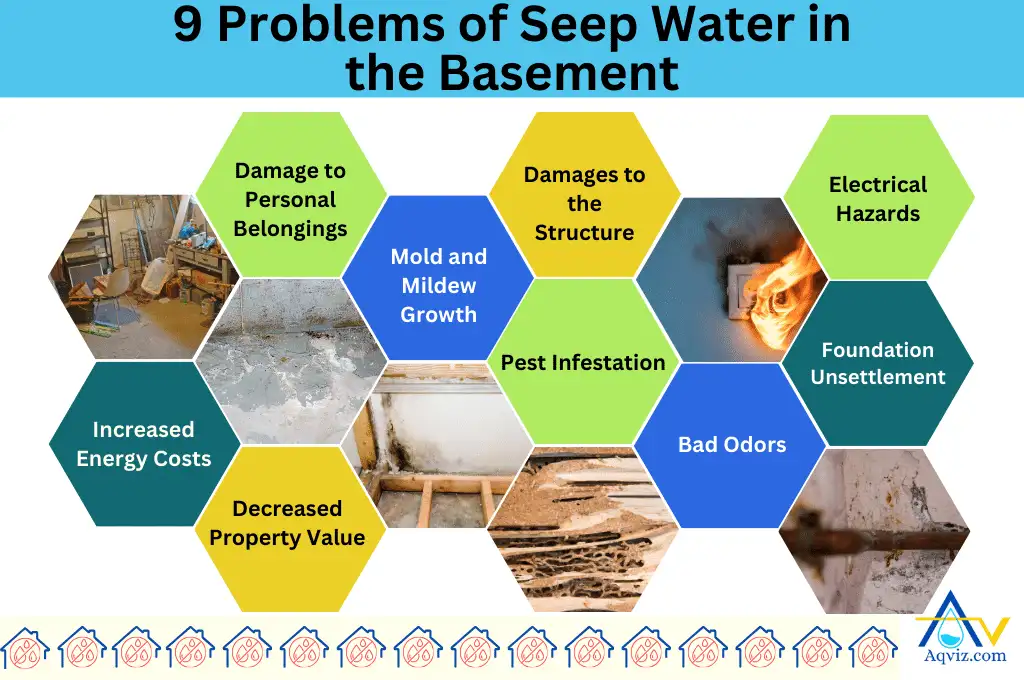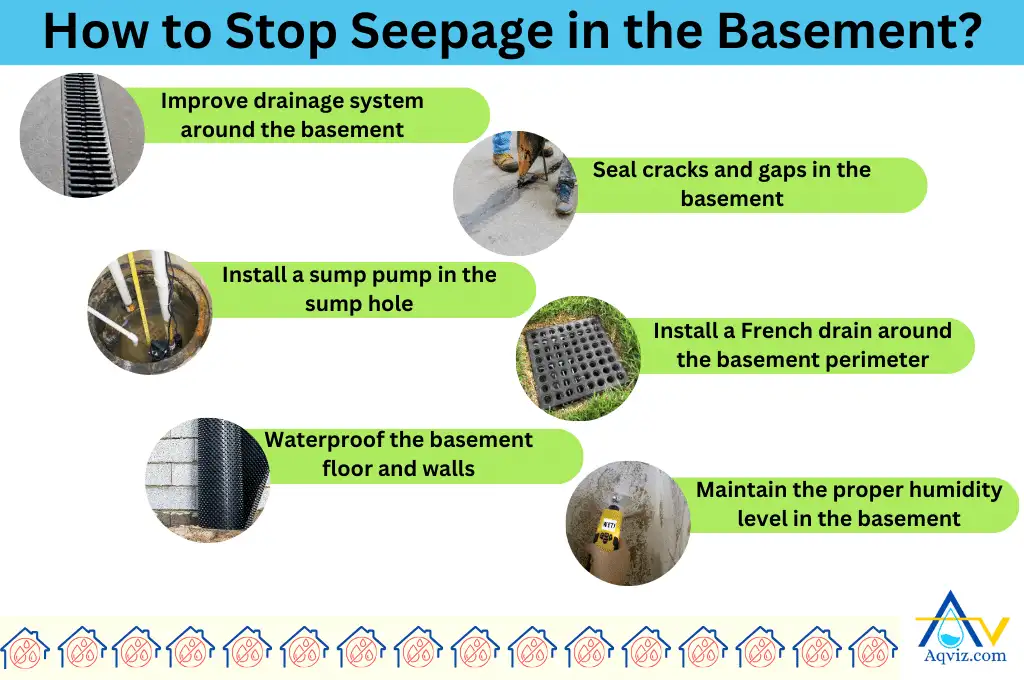Basement Seepage: Signs, Reasons, Problems, and Solutions

Basement seepage is moving water from the outside of the basement through cracks, joints, and porous materials of the basement floor and walls. The seepage rate depends on the pressure of the water source and the material’s porosity.
Basement seepage mostly occurs in basement walls, basement floors, cove joints, foundation cracks, window wells, and nearby pipes in the basement. As well as basement seepage can be identified by the damp or wet walls, pooled water on the floor, peeling paint or bubbling coating, efflorescence deposit, and musty or damp odor in the basement.
The basement seepage problem occurs due to cracks in the basement, high water table close to the basement, higher hydrostatic pressure, rainy or snow melting, inadequate drainage system, poor basement design, improper land grading, and issues in the window and door sealings. When the basement seepage is prolonged, it causes damage to the personal belongings, damage to the structure, mold and mildew growth, bad odors, decreased property value, increased energy cost, pest infestation, electrical hazards, and foundation settlements.
Aqviz experts highly recommend that you improve the basement drainage system, seal cracks and gaps in the basement, install a sump pump, install a French drain, install a waterproofing membrane, and maintain a proper humidity level in the basement to stop the water seepage in the basement.
What is Seepage in the Basement?
Basement seepage is moving water from the outside of the basement through cracks, joints, and porous materials of the basement floor and walls. The seepage rate depends on the pressure of the water source and the material’s porosity. The basement seepage can increase due to groundwater rising in the rain and snow-melting seasons.
The basement seepage is a serious problem for homeowners. It can cause damage to the basement, foundation walls, and floor. Mold and mildew growth, stain marks, dampness, leaking, and material deterioration are the major problems of water infiltration in the basement. Due to these problems, basement strength can be reduced over time.

What are the 5 Signs of Basement Seepage?
Basement seepage can be identified by the damp or wet walls, pooled water on the floor, peeling paint or bubbling coating, efflorescence deposit, and musty or damp odor in the basement.
- Damp or wet walls : Basement seepage can be identified by the damp or wet walls in the basement. When water seeps through porous concrete or block walls, hydrostatic pressure forces groundwater into the interior, creating visible wet spots or damp streaks, especially noticeable after heavy rain or snowmelt.
- Pooled water on the floor : Basement seepage can be identified by standing water on the basement floor. Seepage through floor cracks, wall-floor joints, or around plumbing penetrations can accumulate over time and create puddles, especially in low-lying areas.
- Peeling paint or bubbling coatings : Basement seepage can be observed through peeling paint and bubbling coatings on basement walls or floors. Moisture behind the surface causes adhesion failure, leading to flaking, blistering, or complete delamination of paints and waterproof coatings.
- Efflorescence deposits : Efflorescence is a major sign of basement seepage. It appears as a powdery white residue when salts from inside concrete, brick, or stone dissolve in seeped water and re-crystallize on the surface as the moisture evaporates.
- Musty or damp odors : Constant basement seepage contributes to high humidity and supports the growth of mold and mildew in organic materials. These microorganisms release a stale, musty odor that signals long-term moisture retention.
- Cracks in walls or floors : Basement seepage can cause or worsen structural cracks in walls and floors. Continuous water pressure and material saturation weaken the concrete, leading to visible cracks that become active entry points for more water.
Where Does Basement Seepage Mostly Occur?
Basement seepage mostly occurs in basement walls, basement floors, cove joints, foundation cracks, window wells, and nearby pipes in the basement.
- Basement wall seepage: Basement wall seepage is seeping water from the basement wall due to a poor drainage system, cracked basement walls, using lower porosity materials, extremely high outside pressure, issues with the home’s guttering and downspout system.
- Basement floor seepage: Basement floor seepage is water rising through the concrete slab floor caused by high hydrostatic pressure, groundwater buildup under the slab, clogged footing drains, missing vapor barriers, or poor soil compaction during construction in the basement.
- Cove joint seepage: Cove joint seepage is water entering through the joint where the basement wall meets the floor due to rising groundwater due to lack of a footing drain system, failed exterior waterproofing, or pressure buildup during heavy rain or snowmelt.
- Foundation crack seepage: Foundation crack seepage is water leaking through visible or hidden cracks in concrete or block foundation walls caused by settlement, shrinkage, temperature changes, or structural shifting without proper crack sealing or reinforcement.
- Window well seepage: Window well seepage is water leaking around basement windows from clogged window well drains, missing covers, poor grading around the home, or when the window is set below the exterior soil level without proper drainage in the basement.
- Pipe penetration seepage: Pipe penetration seepage is water entering the basement around utility or plumbing pipe entries due to poor sealing, deteriorated waterproofing materials, vibration cracks, or faulty cement packing around pipe sleeves near the basement.
Read more: Water Seepage: Negative Effect of Building

What are the 10 Reasons for Basement Seepage?
The basement seepage can increase due to human activities and environmental effects. Below are the 11 reasons for increasing the seepage in the basement.
- Cracks in the basement walls: Foundation wall cracks, joints, and seams allow to seep the water in the basement.
- High water table close to the basement: A higher water table close to the basement can increase the water pressure. Hence, it can increase the basement seepage.
- Higher hydrostatic pressure due to basement height: When the basement height is increased, the water table height will increase, and the pressure will rise. As a result of this, basement seepage can rise.
- Rainy and snow melting: Rain and snow melting can raise the groundwater table. It tends to rise the water table and seepage of the basement.
- Inadequate drainage system at the basement: An inadequate basement system will not drain the close water outside of the basement walls. Hence, it tends to raise the water pressure at the basement walls and increase the seepage.
- Poor basement design: Poor basement design and construction can block the natural water flow in the ground. It tends to seep into the basement over time with the rain or snow melting.
- Improper land grading: Improperly graded landscaping that slopes towards the foundation instead of away from it can direct water toward the basement. It can accumulate water at the basement walls.
- Improper garden design: Improper garden design can increase the seepage in the basement due to watering the garden. When the slope is towards the basement, it tends to seep water inside.
- Window and door issues: Inadequate window well drainage or poorly sealed window wells, and doors can allow water to enter the basement through windows and doors.
What are the 9 Problems of Basement Seepage?
The major 9 problems of the seeped water in the basement are damage the personal belongings, damage to the structure, mold and mildew growth, bad odors, decreased property value, increased energy cost, pest infestation, electrical hazards, and foundation settlements.
- Damage to personal belongings: Seeped water can damage furniture, electronics, and other personal belongings in the basement.
- Damages to the structure: Seeped water can weaken the foundation of the house. It tends to develop cracks and collapse in the basement.
- Mold and mildew growth: Moisture in the basement creates a perfect environment for mold and mildew to grow. This can lead to health problems, such as allergies and respiratory issues, for the people living in the house.
- Bad odors: The presence of seepage water in the basement can cause unpleasant smells throughout the house. The combination of mold and stagnant water can create a musty odor that is difficult to eliminate.
- Decreased property value: A wet or damp basement can significantly reduce the value of a property. Potential buyers may be deterred by the possibility of ongoing water damage and the need for costly repairs.
- Increased energy costs: A wet basement can increase the humidity levels in the house, making it more difficult for the HVAC system to maintain a comfortable temperature. This can lead to higher energy bills.
- Pest infestation: Seepage of water in the basement can attract pests such as rodents, insects, and termites. These pests can cause further damage to the structure of the house and can pose health risks to the inhabitants.
- Electrical hazards: If there are electrical outlets or wiring in the basement, seeping water can create a dangerous situation. Water can cause short circuits and electrical shocks, putting both the house and its occupants at risk.
- Foundation settlement: Seepage of water in the basement can affect the stability of the foundation. It causes the foundation to settle. This can result in cracks in the walls, uneven floors, and other structural issues that can be costly and time-consuming to fix.
Related Topic: Basement Humidity: Levels, Variations, Impacts and Controling

How to Stop Basement Seepage?
You can stop the basement seepage by following the 6 methods below.
- Improve the drainage system around the basement: You should improve the drainage system around the basement. You should ensure that your gutters and downspouts are directing water away from the foundation.
- Seal cracks and gaps in the basement: You can seal the cracks and gaps in the basement by using hydraulic cement or a waterproof sealant to fill any visible cracks or gaps in the basement walls or floor.
- Install a sump pump in the sump hole: You can install a sump pump in the sump hole. It can help to remove excess water from the basement. It works by collecting water in a pit and then automatically pumping it away from the house.
- Install a French drain around the basement perimeter: You can install a French drain outside the basement. A French drain is a trench filled with gravel or perforated pipe that collects and redirects water away from the basement.
- Waterproof the basement floor and walls: You can waterproof the basement using a coating or membrane on the exterior walls. You should have done this during the basement construction process. This can help prevent water from seeping through the walls.
- Maintain the proper humidity level in the basement: You can use a dehumidifier in the basement to control moisture levels and prevent condensation. Additionally, you can improve the ventilation by opening windows or using fans to circulate air in the basement.

What are the Differences Between Basement Seepage and Leakage?
There is a difference between basement water seepage and leakage. The difference between these are based on the water flow.
Basement water seepage is moving water from the outside of the basement through cracks, joints, and pores of the basement floor and walls. This is an invisible process, and it tends to cause moisture damage, mold growth, and a weakened structure.
Basement leakage is water flowing from outside as water flows or drips. Basement leakage can cause sudden flooding and property damage in the basement.
